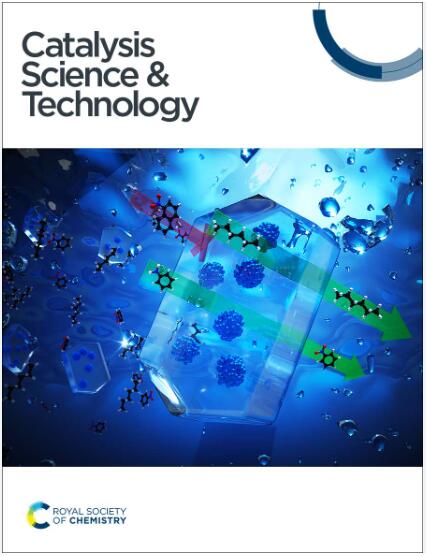高效的CeO2和CeO2 - al2o3载体Ru作为第三代氨合成催化剂:比商业Ru/CeO2†增强的动力学机制
IF 4.4
3区 化学
Q2 CHEMISTRY, PHYSICAL
引用次数: 0
摘要
以前报道过铈(CeO2)作为钌(Ru)的功能载体作为氨合成催化剂。然而,实验室合成的二氧化铈材料通常呈现低表面积,从而限制了氧空位的产生和氨合成活性,这是由于弱金属支撑相互作用的结果。为了克服这一问题,我们通过简单的浸渍法制备了高比表面积的铈和铈-氧化铝负载钌催化剂,并在中等温度下提高了氨合成性能。从这个意义上说,实验室合成的Ru/CeO2(比表面积高,结晶度低于商品铈)比商品样品表现出更强的金属-载体相互作用,这导致了更好的整体氨合成动力学机制,具有更多的正氢反应级(即更耐氢抑制)和更低的活化能(46比61 kJ mol−1)。我们发现,使用氧化铝作为结构载体增加了铈的表面积,从而促进了Ru-CeO2的相互作用和催化性能。我们分析了两种不同的商品氧化铝(酸性和碱性)具有相似的表面积的表面化学的影响。与酸性氧化铝相比,碱性氧化铝在更大程度上增加了催化剂的比表面积。因此,在400℃和环境压力下,碱式氧化铝用量为50%的Ru/ CeO2-Al2O3催化剂的氨合成活性为1.9 mmol g−1 h−1,活化能低至44.8 kJ mol−1。本文章由计算机程序翻译,如有差异,请以英文原文为准。
Efficient CeO2 and CeO2–Al2O3 supports for Ru as 3rd generation ammonia synthesis catalysts: enhanced kinetic mechanism over commercial Ru/CeO2†
Ceria (CeO2) has been previously reported as a functional support for ruthenium (Ru) as an ammonia synthesis catalyst. However, lab-synthesized ceria materials usually present low surface areas, thereby limiting the generation of oxygen vacancies and the ammonia synthesis activity as a result of weak metal–support interactions. With the aim of overcoming this issue, we prepared, by a simple impregnation method, high surface area ceria and ceria–alumina supported Ru catalysts with improved ammonia synthesis performance at moderate temperatures. In this sense, lab-synthesized Ru/CeO2 (with higher specific surface area and lower crystallinity than commercial ceria) showed stronger metal–support interactions than the commercial sample, which resulted in a superior global ammonia synthesis kinetic mechanism with more positive hydrogen reaction orders (i.e., more resistant to hydrogen inhibition) and significantly lower activation energies (46 vs. 61 kJ mol−1). We found that the use of alumina as a structural support increased the surface area of ceria, thereby promoting the Ru–CeO2 interaction and the catalytic performance. We analyzed the effect of the surface chemistry of two different commercial aluminas (acidic and basic) with similar surface areas. Basic alumina was found to increase the specific surface area of the catalyst to a larger extent as compared to acidic alumina. Thus, the Ru/CeO2–Al2O3 catalyst with 50 wt% of basic alumina showed an ammonia synthesis activity of 1.9 mmol g−1 h −1 at 400 °C and ambient pressure and an activation energy as low as 44.8 kJ mol−1.
求助全文
通过发布文献求助,成功后即可免费获取论文全文。
去求助
来源期刊

Catalysis Science & Technology
CHEMISTRY, PHYSICAL-
CiteScore
8.70
自引率
6.00%
发文量
587
审稿时长
1.5 months
期刊介绍:
A multidisciplinary journal focusing on cutting edge research across all fundamental science and technological aspects of catalysis.
Editor-in-chief: Bert Weckhuysen
Impact factor: 5.0
Time to first decision (peer reviewed only): 31 days
 求助内容:
求助内容: 应助结果提醒方式:
应助结果提醒方式:


